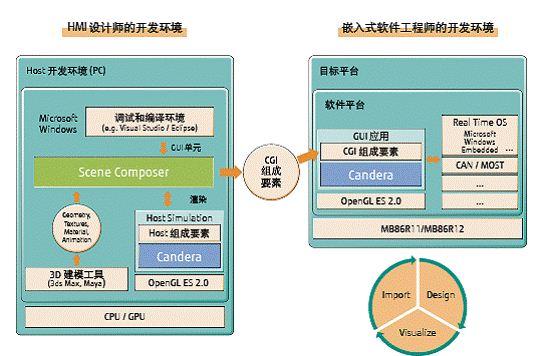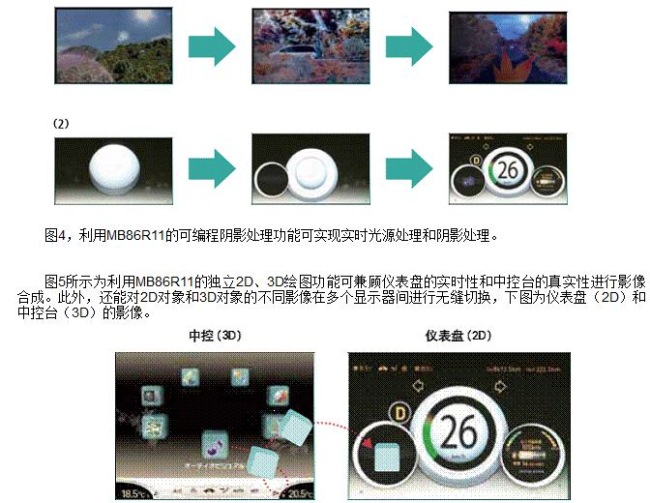In recent years, in order to achieve safety and comfort of automobiles, HMIs that are easier to operate and easier to understand are favored. In order to allow drivers to obtain a variety of information, the display of the dashboard system is no longer just a central integrated mode, but more and more display modes such as instrument panel and overhead display are used.
This article refers to the address: http://
In order to achieve multi-display control and seamless image synthesis, it is necessary to meet the requirements of multiple input and output functions, and freely display the acquired navigation information, camera images, DVD images and other data according to the size of the output objects such as the center console and the dashboard. In addition, the output object can also be set as a rear seat entertainment system and a liquid crystal endoscope. These new trends certainly require the right technology and development platform to work with.
The following is a special introduction to Fujitsu Semiconductor to recommend a car graphics system-on-chip ( SoC )-MB86R11 chip that is most suitable for HMI development.
Optimized development environment
HMI makes car handling easier and easier to understand. Fujitsu Semiconductor's development platform consists of a car graphics system-on-chip system and an authorization tool, which is most suitable for the development of HMI systems (Figure 1).
Multi-monitor control combines images seamlessly and seamlessly, and produces images that combine authenticity with real-time performance. In addition, Fujitsu Semiconductor provides a development environment that enables designers and embedded software developers to work together to reduce the amount of creative development and software development.
The MB86R11 is a high performance automotive graphics SoC for multi-display/multiple data entry systems. Its 3D, 2D human-machine interface software development platform enables user interface designers and application development engineers to work together. Its independent drawing function can display vehicle information such as speed at 60fps while displaying high-level and texture HMI, achieving image synthesis and realism and real-time.
The SoC chip can use the development tool CGI Studio to provide a development environment for HMI designers and embedded system developers to eliminate rework in the creative development process, and to strengthen the cooperation between designers and embedded developers in the joint design work. Since the development platform can automatically generate source code and perform performance verification on a personal computer, the development efficiency of the software can be improved. This provides an opportunity to demonstrate creativity, software development, and reduced commissioning effort.

Figure 1. Optimized development environment.
Efficient design development
When implementing integrated control of multiple displays, engineers do not need to consider the hardware control of horizontal and vertical sync signals, and can use camera functions (abstract) to control multiple displays. The seamless display of 2D/3D objects can be realized between the displays, so that the display design and movement of the instrument panel and the center console are harmonious.
In addition, due to the high compatibility of the general 3D/2D data made by the design tool, the data can be read smoothly. In addition, the size and position of the 2D/3D data image read in can also be edited. Multiple scenes and animations can be created simultaneously, and timeline animations can be produced, thus shortening the design and development cycle. This makes the design work more efficient.
To reduce the amount of debugging and tuning, the MB86R11 runs its embedded environment and applications on a personal computer and performs simulation and performance verification. In the processing time period of a specific interval, by calculating the CPU load rate and the frame transmission rate, the bottleneck can be found and adjusted in time, thereby improving the processing efficiency.
MB86R11 is feature-rich
The MB86R11 has a lot of features. Its built-in four video input ports can handle a variety of different video images simultaneously. The input port supports resolutions up to 1280 x 720 pixels, zooming, and motion-adjustable interlaced/progressive format conversion to produce the least noisy image. One of the video input ports handles interlaced video input up to 1920 x 1080 pixels and supports input of digital TV images.
Three output display controllers are built in, two of which are multiplexed and each output two displays for a total of up to five display outputs. With eight levels of display and inter-layer blending, the outline of the image overlaid on the background map is blurred, allowing the image to blend into the surrounding background. In addition, the dithering function and the gamma correction function enable the image to be displayed with high quality even under different resolutions and color attributes. Built-in programmable shaders accurately render light reflections and shadows, making the image look finer and more realistic. A dedicated video processing engine for edge enhancement, color correction, and backlight adjustment, and improved contrast at night to capture higher quality video images. In addition, backlight brightness is automatically adjusted based on video stream data to reduce system power consumption.
In the multi- display integrated HMI system, the MB86R11 can control two displays (resolutions of 800×600 and 1024×768) and draw and display 2D and 3D data. Figure 2 is a block diagram of the hardware of the evaluation panel of the multi-display integrated HMI system.

Figure 3. CGI Studio enables simultaneous control of display output at different resolutions and seamless switching of 2D objects.
Real-time light source processing and shadow processing can be realized by the programmable shadow processing function of MB86R11, which realizes the textured image display, as shown in Figure 4(1) below. In addition, with the 2D function, animation can be displayed without the participation of the CPU, as shown in Figure 4 (2) below.

Figure 5 shows the image synthesis using the independent 2D and 3D drawing functions of the MB86R11 to take into account the real-time performance of the instrument panel and the authenticity of the center console.
In short, CGI Studio's multi-display system can simultaneously design and animate multiple scenes such as dashboard image (2D) and console screen (3D). In Bitmap animation design, source code can be automatically generated to shorten development. cycle. In addition, before the generated image is used in the embedded environment of MB86R11, the operation confirmation and performance analysis can be performed on the computer through 2D/3D integrated simulation, so the debugging cycle can be shortened.
custom wireless keyboard,wireless keyboard ergonomic,wireless keyboard gaming,wireless keyboard hot swappable
Dongguan Yingxin Technology Co., Ltd. , https://www.yxsparepart.com